**Author: Biteye Core Contributor Louis Wang
**
**Editor: Biteye Core Contributor Denise
**
While most DeFi projects celebrate reaching over 10,000 daily active users, Hyperliquid has quietly processed over $1 billion in daily trading volume. This 10-person team, led by Harvard Physics Olympiad gold medalist Jeff Yan, proves a simple truth by rejecting VC funding: true innovation does not require capital support, but rather a dedication to technology and a deep understanding of user needs.
HYPE token price is $42.5, with a market cap of $14.2 billion, ranking 12th among all cryptocurrencies; cumulative trading volume is $2.2 trillion, capturing over 70% of the DEX perpetual contract market; user base has grown from 350,000 in 2024 to over 600,000 active wallets in 2025; BTC perpetual contract trading volume has reached 10% of Binance's. Behind these impressive numbers is a story of how technological innovation is redefining decentralized finance.
01 Explosive Growth Market Data
1.1 Astonishing Growth in Trading Volume
Hyperliquid has grown from zero to over 600,000 users in just two years, with a growth trajectory that can be described as phenomenal. The project was quietly launched in 2023 without a press conference or marketing budget; Jeff Yan simply "opened the door and watched what happened." The result was explosive: within just 100 days, daily trading volume surpassed $1 billion. On January 19, 2025, the platform set a historical trading record of $21 billion in a single day, and in July, it reached a new monthly trading volume high of nearly $320 billion, a 47% increase from June's $216 billion. This trading volume brought Hyperliquid's share to 11.89% of Binance's, setting a new high, while Binance's perpetual contract trading volume during the same period was approximately $2.59 trillion. The latest data shows that cumulative trading volume has surpassed $2.3 trillion, with open interest reaching $15.2 billion.
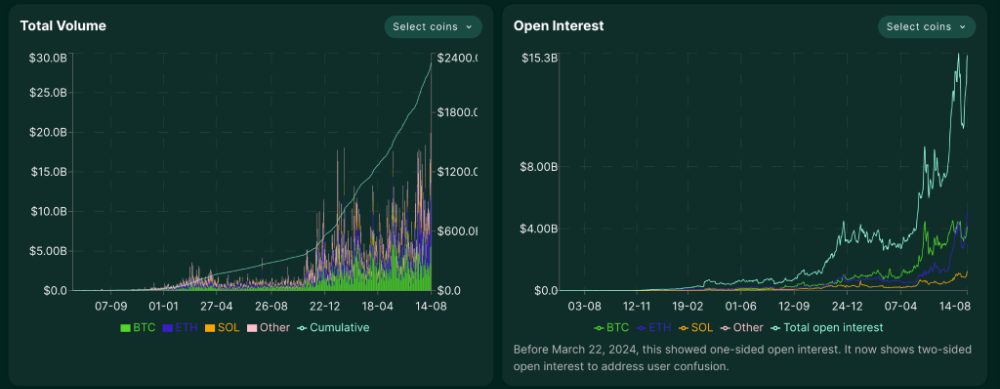
HL's trading volume and OI, https://stats.hyperliquid.xyz/
Currently, HyperLiquid holds over 70% of the trading volume share in the decentralized perpetual contract market, reaching one-tenth of Binance.

Perp dex market share, https://dune.com/uwusanauwu/perps
As analysts point out: "No DEX has ever come this close to the trading volume of top CEXs," Hyperliquid has begun to directly challenge traditional centralized exchanges on certain metrics.
02 Why is Hyperliquid able to capture market share?
2.1 Permissionless Trading Experience without KYC
Unlike traditional centralized exchanges, Hyperliquid offers a truly permissionless trading experience. Users can start trading simply by connecting their wallets, without the cumbersome identity verification process. This freedom attracts a large number of traders who value privacy and convenience, especially those who are unwilling or unable to complete KYC.
2.2 Greater Position Flexibility
Traditional CEXs often impose heavy restrictions on large trades and high-leverage operations, while Hyperliquid's decentralized nature allows users to open larger positions. The platform supports up to 50x leverage, and the restrictions on trade size are more lenient, making it highly attractive to professional traders and institutional investors.
2.3 Fully Transparent On-Chain Execution
All orders, cancellations, trades, and liquidations are executed transparently on-chain, allowing users to verify the fairness of transactions in real-time. This transparency is particularly valuable in the wake of failures at centralized platforms like FTX, providing users with a foundation of trust.
2.4 Revolutionary Breakthroughs in Technical Performance
Hyperliquid addresses the fundamental performance issues of DeFi trading through its self-built Layer 1 blockchain:
Transaction Speed: Sub-second confirmation, comparable to top CEXs
Throughput: 200,000 TPS, far exceeding other DEXs' 2,000 TPS
Gas Fees: Completely free for users
Order Book: Fully on-chain, real-time matching
Jeff Yan identified the problems with traditional blockchains: "Ethereum is too slow. Layer 2 solutions add latency. Solana is relatively fast, but still not fast enough for serious trading." Therefore, he decided to build a blockchain designed specifically for trading from the ground up.
03 Innovative Vault Mechanism: A Double-Edged Liquidity Solution
3.1 How the HLP Vault Works
Hyperliquid's HLP (Hyperliquid Liquidity Provider) vault is the core of the platform's liquidity system. This mechanism automatically executes market-making strategies through algorithms, providing deep liquidity for the platform while allowing ordinary users to participate in professional-level market-making profits.
Advantages of the Vault Mechanism:
Provides stable liquidity support for the platform
Allows ordinary users to participate in professional market-making strategies
Transparent earnings, fully verifiable on-chain
Effectively reduces trading slippage
As shown in the figure, a single trade of $100,000 in BTC or ETH on HL can achieve 0 slippage.
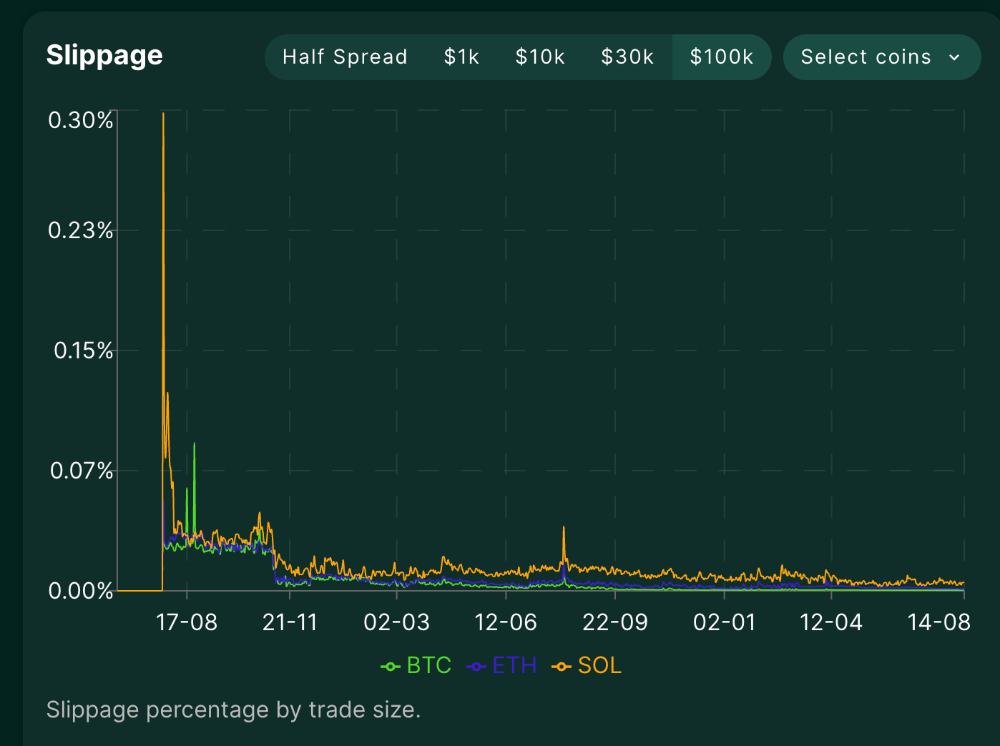
Slippage for different trade amounts https://stats.hyperliquid.xyz/
3.2 Risk Exposure of the Counterparty Mechanism
However, the Vault mechanism also brings systemic risks, which were fully exposed during the JELLY incident in March 2025.
Review of the JELLY Attack Incident:
On March 26, 2025, an attacker controlled 124.6 million JELLY tokens, first selling them in large quantities to push the price down, causing HLP to passively take on a $15.3 million short position. The attacker then bought large amounts on the decentralized exchange to push the price up, resulting in a 400% surge in JELLY's price within an hour, with unrealized losses for HLP reaching $13.5 million at one point.
At that time, HyperLiquid faced an unprecedented public relations crisis, and the price of the HYPE token fell to a historical low (which, in hindsight, was the best buying opportunity). However, HyperLiquid responded quickly to the crisis: validators reached consensus within two minutes to urgently take down the JELLY market; all positions were forcibly liquidated at the attacker's opening price; and the Hyper Foundation promised to compensate all normal users.
The system mechanism of HLP was also rapidly improved after this crisis:
ADL mechanism optimization: no longer based on overall asset calculations, but separately monitoring liquidation pool losses
Position limits strengthened: reassessing risk parameters for low market cap tokens
Liquidation mechanism reinforced: reducing the proportion of the liquidation pool to decrease risk exposure
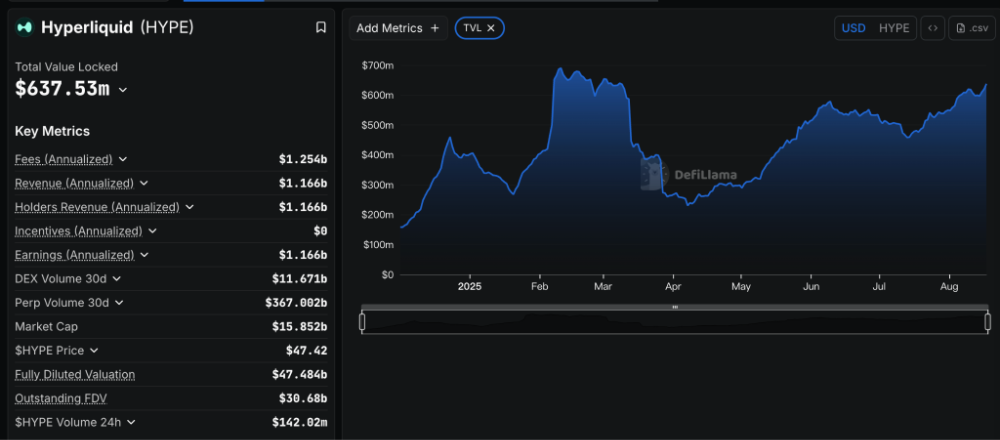
HLP TVL, https://defillama.com/protocol/hyperliquid?tvl=true&events=false
Recovery data after the incident shows: TVL recovered from a low of $19.7 billion to $20.8 billion, HLP assets fully recovered to $19.5 billion, and trading volume stabilized from $50 million/day to $140 million/day, demonstrating the platform's strong resilience.
04 Revolutionary Value Capture: Redefining Token Economics
4.1 Unprecedented Buyback Commitment
While most DeFi projects are still debating how to allocate protocol revenue, Hyperliquid made a shocking decision: to use 97% of protocol revenue for HYPE token buybacks.
Based on the platform's 7-day average trading volume, Hyperliquid buys back approximately 76,000 HYPE tokens daily, with an annualized buyback rate of 4.7% of the circulating supply. The cumulative buyback value has exceeded $900 million, and currently, 41.85% of the total supply is staked and locked, creating a strong supply contraction effect.
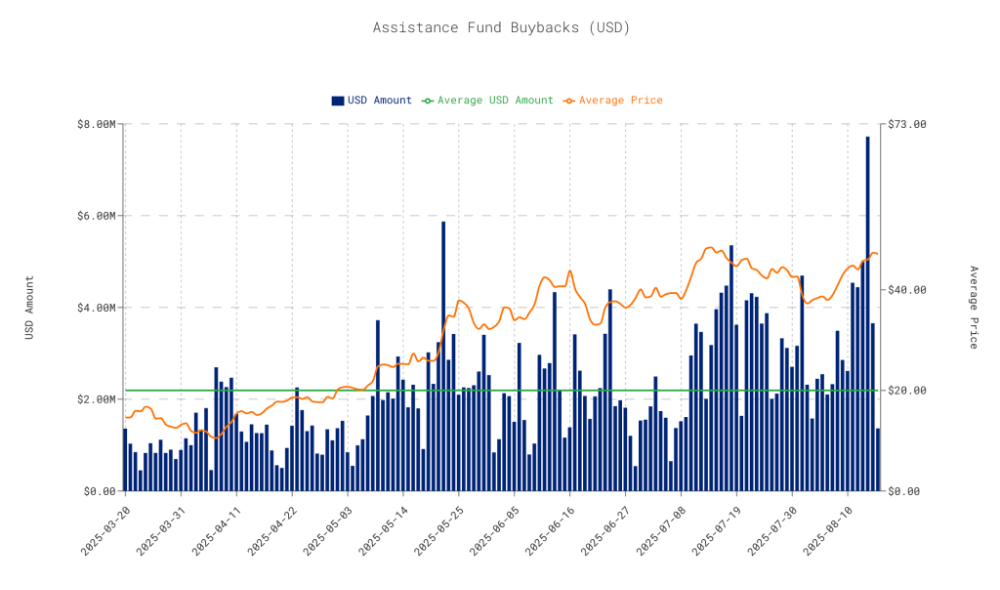
Hyperliquid buyback records, https://data.asxn.xyz/dashboard/hl-buybacks
The brilliance of this design lies in its ability to directly convert the platform's commercial success into an increase in token value. As trading volume grows, the buyback intensity automatically increases, forming a positive value cycle. This is not a simple deflationary mechanism, but a real dividend model that returns protocol revenue directly to token holders.
4.2 Multi-Dimensional Value Realization
The value capture of the HYPE token is not limited to buyback and burn; as a Layer 1, it also has node staking rewards, with yield design referencing Ethereum's PoS consensus mechanism, where the yield is inversely proportional to the square of the staked HYPE amount, currently around 2.2%. On-chain data shows that over 32 million HYPE tokens are already participating in staking, accounting for about 42% of the circulating supply, with 23% being liquid staking (such as kHYPE).
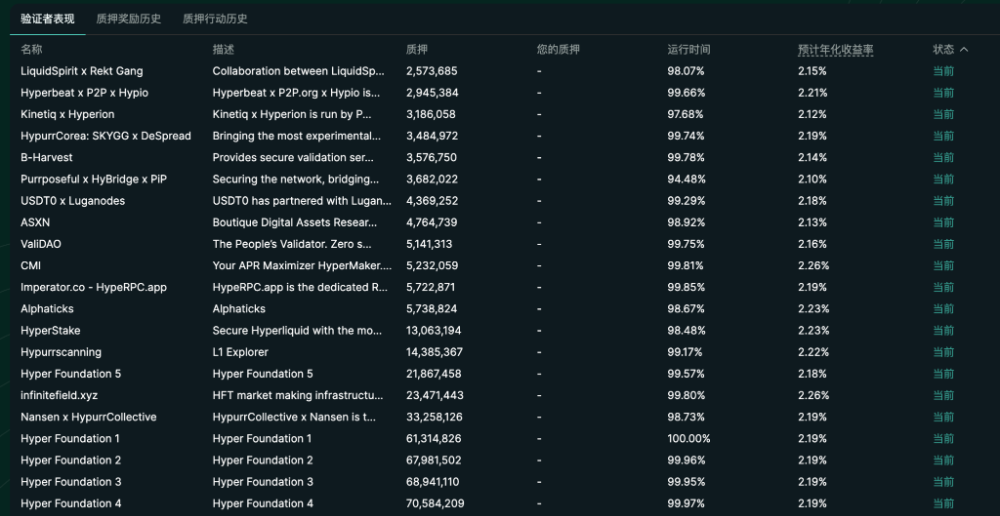
HYPE node staking yield, https://app.hyperliquid.xyz/staking
4.3 A Brave Experiment Rejecting VC
In an industry dominated by venture capital, Hyperliquid has chosen a completely different path. The project allocates 70% of its tokens to user airdrops and community rewards, 23.8% to the team and core contributors, 6.2% for future development funds, and the proportion of VC investment is zero.
The revolutionary aspect of this distribution model is that it completely avoids the VC sell-off pressure typical of traditional projects. In the traditional model, VCs often sell off large amounts of tokens for profit after they go live, while Hyperliquid's model ensures the stability of token prices, allowing real users and builders to become the biggest beneficiaries. As Jeff Yan said, allowing venture capitalists to hold large stakes in a decentralized network would become "the scar of the network."
05 HYPE Token: An Undervalued Value Pit
5.1 Investment Logic Supported by Strong Fundamentals
From a purely investment perspective, the HYPE token possesses all the elements of a successful investment target. First, there is a strong business foundation: the platform's annual revenue has reached $577 million, and this figure comes solely from trading fees, excluding other potential revenue sources. The user base has rapidly grown from 350,000 active wallets in 2024 to over 600,000 in 2025, with user retention rates ranking among the best in the industry.
More importantly, this growth is based on real product value rather than speculative hype. Hyperliquid's market share continues to expand, and it has begun to directly challenge traditional centralized exchanges on certain metrics, providing significant room for future growth.
Since the beginning of the year, HYPE has risen approximately 83%, significantly outperforming Bitcoin and Ethereum. Its high correlation of 0.703 with Bitcoin indicates that HYPE enjoys additional returns driven by its fundamentals while benefiting from the overall rise in the crypto market.
5.2 Long-Term Value Built on a Technical Moat
The investment value of HYPE comes not only from short-term business growth but also from the technical moat built by Hyperliquid. The self-developed Layer 1 blockchain, 200,000 TPS processing capability, and sub-second transaction confirmations are technical advantages that cannot be easily replicated by other projects in the short term.
In a DeFi market filled with homogeneous competition, Hyperliquid has established a true differentiated advantage through technological innovation. The value of this moat will continue to amplify over time, providing solid support for the long-term value of the HYPE token.
5.3 HIP-3: Building a New Infrastructure for Financial Innovation
The HIP-3 proposal represents Hyperliquid's strategic transformation from a trading platform to financial infrastructure. This mechanism allows anyone to create custom perpetual contract markets on the platform by staking 1 million HYPE tokens, including setting price oracles and contract specifications.
This innovation addresses the core pain points created by traditional financial markets. In the traditional system, the launch of new financial products requires lengthy regulatory approvals, incurs massive costs, and is often limited to large financial institutions. HIP-3 provides a permissionless market creation platform where any innovator can quickly validate and deploy their financial product ideas.
From a business model perspective, HIP-3 creates a brand new value capture mechanism. The creation of each new market requires a significant amount of HYPE tokens to be staked, creating a continuous rigid demand for the token. At the same time, market creators can earn a portion of the transaction fees from the markets they create, forming a profit-sharing mechanism between innovators and the platform.
For the value of the HYPE token, HIP-3 signifies the diversification of demand drivers. In addition to trading fees and staking rewards, the demand for market creation will become a new growth point for token value, providing a more solid foundation for long-term value growth.
5.4 Pre-IPO Trading: Breaking Traditional Investment Barriers
Based on the HIP-3 mechanism, a revolutionary application case has emerged within the Hyperliquid ecosystem: the Ventuals platform. This protocol provides a decentralized solution for one of the most closed areas in traditional finance—pre-IPO trading.
Pre-IPO trading refers to the activity of trading shares or related derivatives of a company before it officially goes public. This asset class, valued in the trillions of dollars, has long been monopolized by institutional investors and venture capital firms, making it nearly impossible for ordinary investors to participate. Traditional pre-IPO investments not only have extremely high entry barriers but also very limited liquidity, often requiring investors to wait years to exit.
The innovation of Ventuals lies in tokenizing the total valuation of these private companies, creating a valuation-based perpetual contract market. For example, if OpenAI is valued at $35 billion, then the price of one vOAI token would be $35 (valuation divided by 1 billion). Investors can trade on the valuation changes of star private companies like OpenAI, Stripe, and SpaceX with up to 10x leverage, either long or short.
The significance of this model goes far beyond the technical innovation itself. It creates synthetic liquidity for private company shares, which traditionally suffer from extreme illiquidity, making the price discovery process transparent and efficient. More importantly, it truly democratizes investment opportunities, allowing ordinary investors to participate in the value growth of these top companies.
For Hyperliquid, pre-IPO trading represents an important step for the platform's penetration into traditional finance. As blockchain technology begins to accommodate the trading needs of traditional financial assets, it not only validates the maturity of the technology but also signals greater market space and value potential.
06 Conclusion: Technological Innovation Redefines DeFi
The success of Hyperliquid proves a simple truth: projects that focus on solving real problems and serving genuine user needs can stand out in fierce competition, even without massive funding and marketing budgets. This decentralized exchange, built by an 11-person team, has made the leap from zero to trillion-dollar valuation in just two years, redefining the standards for DeFi trading platforms.
As Jeff Yan said, "We focus on creating products that users love; everything else is secondary." Behind this seemingly simple philosophy is a relentless pursuit of technological innovation and a deep understanding of user value. Hyperliquid chose not to compromise on existing blockchains but instead built a Layer 1 optimized for trading from scratch; it did not chase VC funding but insisted on user-first value distribution; it did not rely on marketing-driven growth but gained user recognition through the excellent experience of the product itself.
From an investment perspective, the HYPE token possesses all the characteristics of a high-quality investment target: strong fundamentals, an innovative business model, a solid technical moat, and healthy token economics. At the current price level of $42.5, considering the platform's growth rate and market potential, HYPE still holds strong investment appeal.
免责声明:本文章仅代表作者个人观点,不代表本平台的立场和观点。本文章仅供信息分享,不构成对任何人的任何投资建议。用户与作者之间的任何争议,与本平台无关。如网页中刊载的文章或图片涉及侵权,请提供相关的权利证明和身份证明发送邮件到support@aicoin.com,本平台相关工作人员将会进行核查。



